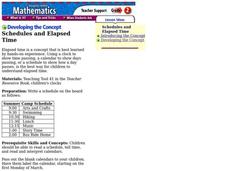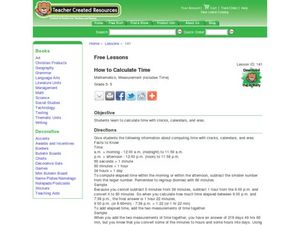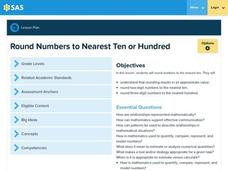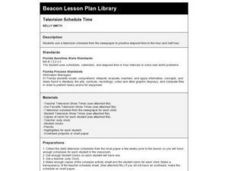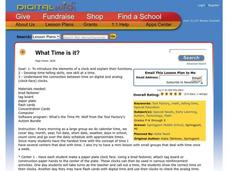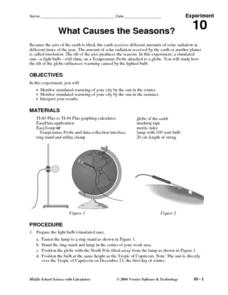Curated OER
Telling Time as an Everyday Use of Numbers
How can we estimate time? Have your young mathematicians make a clock. Then they compare and contrast types of clocks. They practice writing times in two different ways and make a book about telling time.
Curated OER
Telling Time Timeline
Use the Internet and library resources to compose a telling time timeline -- a visual history of time. Students will develop research skills and gain perspective about telling time by discovering the history of clocks and time.
Curated OER
It's About Time!
Students examine concept of time, and explore difference between analog and digital clocks; students make art project to represent time and create a time-story problem and solution.
ESL Kid Stuff
Time Frequency - "How Often ...?"
How often do you ride a bike? Time frequency words are featured in a activity designed for ESL/ELD classrooms.
Curated OER
Aztec Calendar
Young scholars investigate the Aztec calendar. In this Aztec calendar lesson, students look at examples of Aztec calendars, both the solar and lunar calendars. They access web sites to further investigate the calendars before making a...
Curated OER
Schedules and Elapsed Time
Young scholars answer questions about elapsed time in the calendar. In this elapsed time lesson plan, students discuss a schedule that is given to them, and then answer questions about time passing on a March calendar page.
Curated OER
How to Calculate Time
Students complete a worksheet. In this calculations instructional activity, students learn factual information about computing time with clocks, calendars and eras. Students show their knowledge by completing a worksheet.
Pennsylvania Department of Education
Round Numbers to Nearest Ten or Hundred
Third graders review telling time. For this lesson on telling time, 3rd graders discuss various items that show length of time, including clocks, calendars and sand timers. Students review and practice what they already know about...
Curated OER
Television Schedule Time
Students consider the concept of elapsed time by examining television schedules. They list five television shows and highlight them in a newspaper, marking down the beginning and ending time of each show. They use clocks to figure out...
Curated OER
What Time is it?
Young scholars participate in three centers focused on developing time-telling skills. In this time lesson, students create their own paper plate clock face, play "Time Concentration" using times on the hour and half hour, as well as,...
Curated OER
How Often Is it Rainy in July?
Students answer questions related to the calendar and the weather. For this past tense and adverbs of frequency lesson, students use past tense verbs and adverbs of frequency to answer questions about the weather and the calendar.
Curated OER
Chinese Calendar
Third graders listen to a Mak Kam's, "My Chinatown: One Year in Poems," before locating China on a map. They discuss the Chinese language and culture, comparing it to the American culture. They determine which animal sign they were born...
Curated OER
Time Flies When Math Is Fun
Third graders pracdtice telling time with a demonstration clock.
Curated OER
What Teeth Tell Us
Students view pictures of a variety of animals. They examine the animals' teeth and discuss the differences in them. They experiment with staple removers (carnivore teeth) and two flat rocks (herbivore teeth) and determine which are most...
Curated OER
Quel temps fait-il?
Hit all the basics with this lesson, focusing on weather, greetings, and dates! Start by singing a weather related song ("Quel temps fait-il by Barbara MacArthur is suggested), and then read a story about getting ready for school. The...
US Citizenship and Immigration Services
Thanksgiving 3—Traditions
Thanksgiving is a treasured national holiday, but it can look different from table to table. Through a reading passage, real-world images, and class discussion, scholars take a look into Thanksgiving's importance to the...
Curated OER
New Year's Etymology and Writing Activity
Students investigate the history and etymology of New Year's Day. They listen to a teacher-led lecture about the background of New Year's Day, design an image of Janus, and write a story in the first person telling what Janus might say...
Curated OER
What A Beautiful World We Live In
Students create poems, pictures, and essays to show their love of life. They also explain how to get through the difficult times. Finally, they describe what is beautiful in this world that they enjoy.
Curated OER
Why We Count
Students visualize census data on a map and use a map key to read a population map. In this census lesson, students use a map of the Virgin Islands and corresponding worksheets to gain an understanding of population density.
Curated OER
Magnetic Discovery Bottle
Students examine how to conduct simple investigations and use simple equipment to gather data. For this magnet lesson students decide what types of objects are attracted to magnets.
Curated OER
What Causes the Seasons?
Third graders investigate why the seasons occur throughout the year. They read a traditional wisdom story pertaining to the seasons. They create their own wisdom stories about the seasons and act them out for the class.
Curated OER
Lincoln's Birthday
Students in and ESL classroom discover and discuss the importance of Abraham Lincoln and why we celebrate his birthday. They study vocabulary associated with Abraham Lincoln.
Curated OER
The Function Box
Students explore arithmetic and numerical patterns. After observing a teacher created function box, students describe a pattern and predict what will "come out" of the function box. They explore patterns such as geometric shapes,...
Curated OER
Decorating Objects....And Re-Decorating
Students decorate cups or bowls with thematic designs that represent Chinese culture. In this decorating lesson plan, students will decorate their cups or bowls and then “sell” these works of art to partners role-playing as French...





